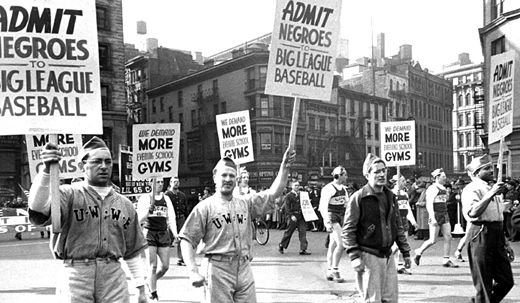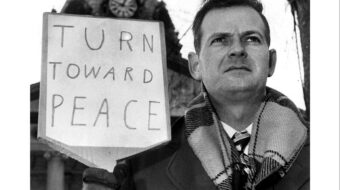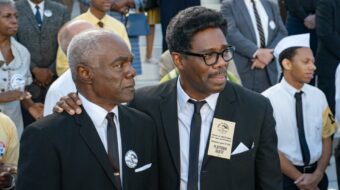
Lester Rodney, who as sports editor for the Daily Worker from 1936 to 1958, helped lead the struggle that broke major league baseball’s color barrier, died Dec. 20 in Walnut Creek, Calif., where he had been living in a retirement community. He was 98 years old.
Rodney’s role in helping to win conditions today’s baseball fans take for granted as they root for teams featuring Black, white, Latino and Asian players, has been celebrated repeatedly in recent years.
The subject of a 2003 book by Irwin Silber, “Press Box Red: The Story of Lester Rodney,” the Communist who helped break the color line in American sports, Rodney was also featured in Dave Zirin’s What’s My Name, Fool? Sports and resistance in the United States (2005). He received invitations to speak and provided commentary for HBO documentaries on the Brooklyn Dodgers.
Rodney was honored by Northern California Friends of the People’s Weekly World at its banquet in 2006. There, he galvanized the audience, including many young people, with his account of the decade-long fight to break the color line.
Recalling Jackie Robinson’s first appearance with the Brooklyn Dodgers in April 1947, Rodney called him “a great American hero.” Robinson, he told the audience, led his team to the pennant despite abuse including from opposing players, an achievement Rodney called “the most amazing and courageous feat in the history of American sports.”
“Jackie Robinson changed baseball, and when you’ve changed baseball in this country, you’ve changed this country!” Rodney said.
Rodney’s story emerges from Silber’s and Zirin’s books and from other recent interviews. The grandson of Jewish immigrants from Europe, he grew up in Brooklyn, N.Y., became a Dodger fan, covered sports for his high school newspaper, played basketball and ran track.
He met members of the Communist Party and started reading the Daily Worker while going to night school at New York University. Disappointed with the paper’s sports coverage, which he felt reflected negative, narrow stereotypes of professional sports, he wrote to the paper suggesting improvements. Soon after, he met with then-editor Clarence Hathaway, who immediately hired him to edit the sports coverage.
Rodney quickly began to focus on baseball owners’ policy of keeping baseball racially segregated, and on the absence of that topic in other papers’ coverage of the sport. He also became active in the Young Communist League.
The campaign to break segregation “just evolved as we talked about the color line and some kids in the YCL suggested, ‘Why don’t we go to the ball parks, to Yankee Stadium, Ebbets Field, the Polo Grounds, with petitions?'”
Fans, the majority white, supported the hiring of African American players, Rodney said. The YCL and its supporters gathered at least a million and a half signatures that were delivered to baseball commissioner Kenesaw Mountain Landis. Labor also played a significant part in the struggle, Rodney said, with unions marching in May Day parades carrying signs reading “End Jim Crow in Baseball!” The African American people, athletes and press were among the first and foremost fighting to end baseball segregation, as well.
The Daily Worker’s sports pages became an engine for the campaign, and Rodney built solid relations with players and with other papers’ sports writers.
Finally in 1947 came Robinson’s debut with the Dodgers, and soon after, other teams began to hire African American and Latino players.
Along the way were many memorable incidents. One was Joe DiMaggio’s response to a reporter’s question about the best pitcher he had ever faced. Much to everyone’s surprise, Rodney said, DiMaggio answered that it was the great African American pitcher, Satchel Paige, against whom he had played in exhibition games. “He knew Paige was Black and that Blacks were banned when he said that,” Rodney recalled. “We had a huge headline the next day. The other papers never reported it.”
In Press Box Red, Rodney explained the campaign’s strategy. “First was to simply raise hell about the color ban and get it into the public consciousness. Second, we set out to popularize the Black stars and document that they could compete on the Big League level. Third, shoot down the notion that the white players and managers wouldn’t stand for it by directly putting the question to them. Fourth, we immediately put the league presidents and the commissioner on the spot by challenging then to say whether there was an official ban, which they denied, of course.”
Lester Rodney is survived by daughter Amy Rodney, son Ray Rodney, granddaughter Jessie Amanda Rodney LaGoy, and his companion, Mary Harvey. His wife, Clare, died in 2004.

MOST POPULAR TODAY

High Court essentially bans demonstrations, freedom of assembly in Deep South

Zionist organizations leading campaign to stop ceasefire resolutions in D.C. area

UN warns that Israel is still blocking humanitarian aid to Gaza

U.S. imperialism’s ‘ironclad’ support for Israel increases fascist danger at home







Comments